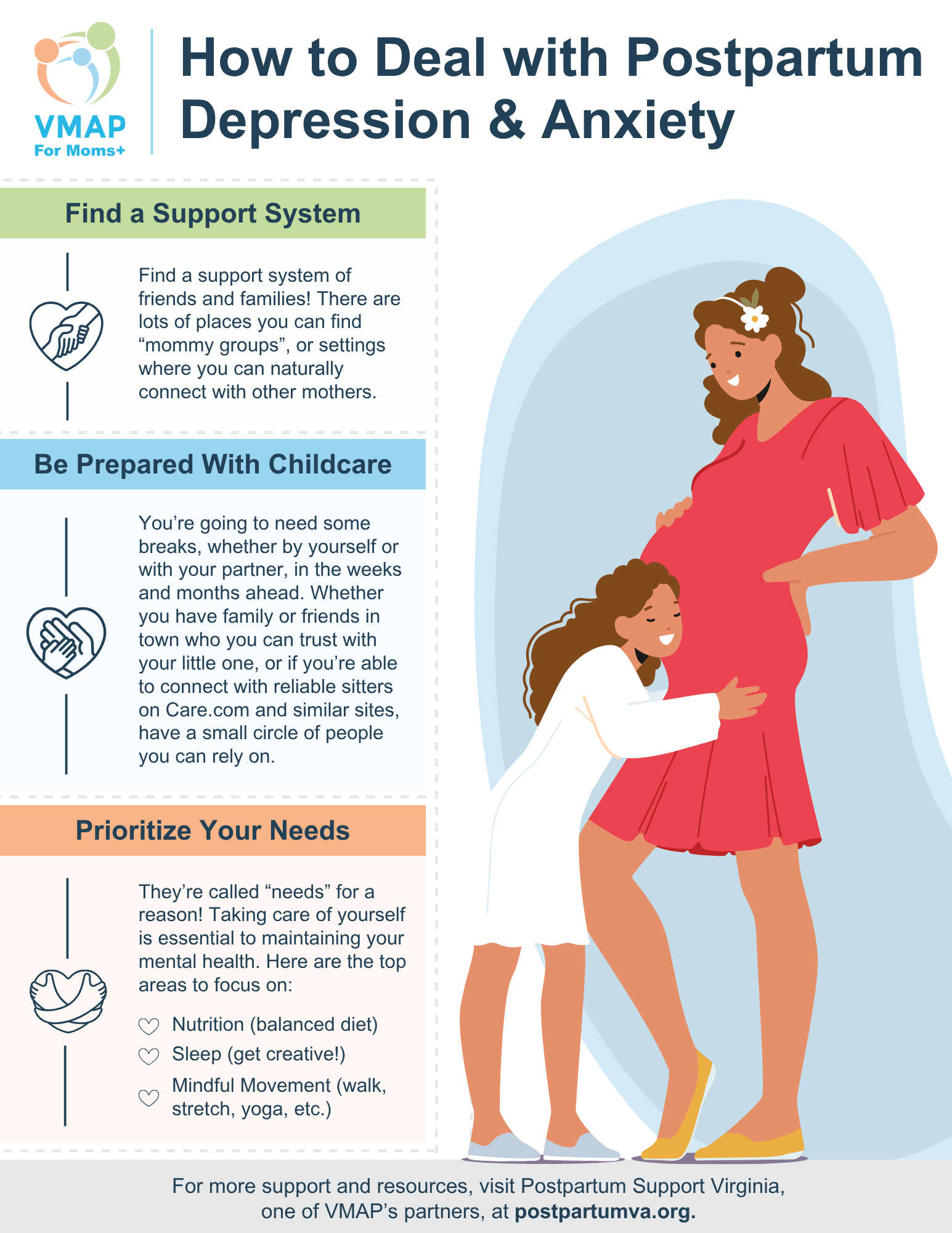How to Deal with Postpartum Depression & Anxiety
Please Note: If you or a loved one recognize that you’re experiencing some of the postpartum depression or anxiety symptoms we listed earlier, reach out to your OB/GYN for support. If they are less familiar with postpartum mental health issues, they can connect with VMAP for Moms+ to speak with experts about your care.
What You Need to Know About Postpartum Depression (PPD)
Up to 20% of mothers will experience depressive symptoms that begin 1-3 weeks after childbirth, and they can last for several years. Some of these symptoms include:
- Feeling sad or crying a lot
- Feeling overwhelmed
- Having thoughts of hurting the baby or yourself
- Lack of interest in the baby
- Having no energy or motivation
- Feeling worthless, guilty, or like you are a bad parent
- Sleeping too much or too little
- Change in relationship with food
- Feeling anxious
- Having chronic headaches, aches, pains, or stomach problems
Postpartum depression is a distinct condition from postpartum blues or "baby blues", which is a period of low mood, irritability, and sadness that affects between 14% – 76% of women during postpartum. That being said, postpartum blues can develop into major depressive disorder if symptoms persist or become severe. One study found that 27.7% of women with postpartum blues ended up developing postpartum depression as a result.
What You Need to Know About Postpartum Anxiety (PPA)
Like postpartum blues, postpartum anxiety is distinct from postpartum depression. Unfortunately, postpartum anxiety has been less studied, though it's estimated that 20% of women struggle with this condition after giving birth.
Postpartum anxiety is defined by:
- Hyperventilation
- Panic attacks
- Excessive or constant worry
- Feelings of dread
- Difficulty concentrating
- Irritability and tension
- Insomnia
- Chest pain
- Heart palpitations
- Sweating
- Trembling
- Tingling in arms or legs
What's The Connection Between Postpartum Depression and Postpartum Anxiety?
Many women who have severe postpartum depression will also have comorbid (i.e., co-occurring) anxiety symptoms. In other words, it's common for these two conditions to occur together. Luckily, many of the tools that can identify postpartum depression are also able to detect postpartum anxiety.
For example, the Edinburgh Postnatal Depression Scale (EPDS) can differentiate between postpartum conditions based on what score someone has. Postpartum women with low scores have no depression or anxiety, higher scores indicate anxiety only, higher indicate depression only, and the highest scores point to both depression and anxiety. Essentially, this screening tool can identify women with significant postpartum symptoms who may need further treatment and intervention.
Risk Factors for Postpartum Depression and Postpartum Anxiety
Anyone can be affected by postpartum depression and anxiety after birth, but here are some of the situations that make it more likely for someone to develop these conditions:
- Having a personal history of depression, anxiety, or another mental illness
- Having a family history of depression, anxiety, or another mental illness
- Having a baby who cries more than expected, has difficulty feeding or sleeping, or is difficult to comfort
- Being either very young or much older at the time of birth
- Being a first-time parent
- Having a baby with special needs, medical complications, or other illness
- Pregnancy complications like health conditions, difficult delivery, or premature birth
- Existing emotional stressors, such as family/partner conflict or death, divorce, financial difficulties
- Experiencing underemployment or unemployment from partner or self
- Feeling isolated from friends, family, or community
- Dealing with teen pregnancy or single parenthood
How to Deal with Postpartum Depression and Anxiety
- Find a Support System
Find a support system of friends and families! There are lots of places you can find “mommy groups”, or settings where you can naturally connect with other mothers. You can often find groups on Facebook, at local community centers, yoga studios, etc. Our VMAP for Moms+ partner, Postpartum Support Virginia, offers peer support and other postpartum resources on their website.
2. Be Prepared with Childcare
You're going to need some breaks, whether by yourself or with your partner, in the weeks and months ahead. Whether you have family or friends in town who you can trust with your little one, or if you're able to connect with reliable sitters on Care.com and similar sites, have a small circle of people you can rely on to care for your child. Whether you're a first-time parent or have had several children, it's always nerve-wracking to trust someone with your child. Here's a checklist that can help you prepare a babysitter to keep your little one safe!
3. Prioritize Your Needs (They're Called "Needs" for a Reason!)
It may feel impossible to meet all your needs and your child's at once. It's definitely difficult, but you can do it – especially if you have the support you need from family, friends, and caregivers. Here are the top three needs to look out for!
- Nutrition: Postpartum is not a time to try and lose weight or "get your body back" – it's a time to nourish your body and help it heal from childbirth. Begin With Balance has a great postpartum meal plan and prep guide for moms who need easy, nourishing meals that can be made in advance, frozen, and reheated as needed – check it out here!
- Sleep: Try your best to get adequate sleep. This might sound impossible, but there are some ways to make it happen – at least for some nights in the week! You can take turns with your partner to get up with the baby during the night, or trade off every other night. If you can, hire overnight help once or twice a week to get the rest you need. Don't be afraid to take naps during the day, or have family, friends, or sitters help out around the house and with the baby while you rest.
- Mindful Movement: Postpartum is also not a time to exercise vigorously or push your body to the limit – it's been through enough already! After your initial period of rest and recovery, it's always a good idea to incorporate mindful movement into your day to boost your mood and manage your stress. Yoga, stretching, and walking are three great examples of mindful movement.
Even if you're able to prepare yourself perfectly for postpartum, you may still experience postpartum depression and anxiety – and that's okay! It's not an indication that you did anything wrong or could've done something differently.
If you or a loved one recognize that you're experiencing some of the postpartum depression or anxiety symptoms we listed earlier, reach out to your OB/GYN for support. If they are less familiar with postpartum mental health issues, they can connect with VMAP for Moms+ to speak with experts about your care.





